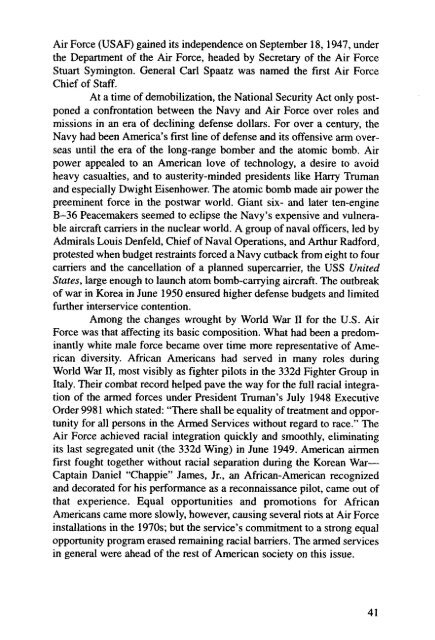A Concise History of the US Air Force - Air Force Historical Studies ...
A Concise History of the US Air Force - Air Force Historical Studies ...
A Concise History of the US Air Force - Air Force Historical Studies ...
Create successful ePaper yourself
Turn your PDF publications into a flip-book with our unique Google optimized e-Paper software.
<strong>Air</strong> <strong>Force</strong> (<strong>US</strong>AF) gained its independence on September 18,1947, under<br />
<strong>the</strong> Department <strong>of</strong> <strong>the</strong> <strong>Air</strong> <strong>Force</strong>, headed by Secretary <strong>of</strong> <strong>the</strong> <strong>Air</strong> <strong>Force</strong><br />
Stuart Symington. General Carl Spaatz was named <strong>the</strong> first <strong>Air</strong> <strong>Force</strong><br />
Chief <strong>of</strong> Staff.<br />
At a time <strong>of</strong> demobilization, <strong>the</strong> National Security Act only post-<br />
poned a confrontation between <strong>the</strong> Navy and <strong>Air</strong> <strong>Force</strong> over roles and<br />
missions in an era <strong>of</strong> declining defense dollars. For over a century, <strong>the</strong><br />
Navy had been America’s first line <strong>of</strong> defense and its <strong>of</strong>fensive arm over-<br />
seas until <strong>the</strong> era <strong>of</strong> <strong>the</strong> long-range bomber and <strong>the</strong> atomic bomb. <strong>Air</strong><br />
power appealed to an American love <strong>of</strong> technology, a desire to avoid<br />
heavy casualties, and to austerity-minded presidents like Harry Truman<br />
and especially Dwight Eisenhower. The atomic bomb made air power <strong>the</strong><br />
preeminent force in <strong>the</strong> postwar world. Giant six- and later ten-engine<br />
B-36 Peacemakers seemed to eclipse <strong>the</strong> Navy’s expensive and vulnera-<br />
ble aircraft carriers in <strong>the</strong> nuclear world. A group <strong>of</strong> naval <strong>of</strong>ficers, led by<br />
Admirals Louis Denfeld, Chief <strong>of</strong> Naval Operations, and Arthur Radford,<br />
protested when budget restraints forced a Navy cutback from eight to four<br />
carriers and <strong>the</strong> cancellation <strong>of</strong> a planned supercarrier, <strong>the</strong> <strong>US</strong>S United<br />
States, large enough to launch atom bomb-carrying aircraft. The outbreak<br />
<strong>of</strong> war in Korea in June 1950 ensured higher defense budgets and limited<br />
fur<strong>the</strong>r interservice contention.<br />
Among <strong>the</strong> changes wrought by World War I1 for <strong>the</strong> U.S. <strong>Air</strong><br />
<strong>Force</strong> was that affecting its basic composition. What had been a predom-<br />
inantly white male force became over time more representative <strong>of</strong> Ame-<br />
rican diversity. African Americans had served in many roles during<br />
World War 11, most visibly as fighter pilots in <strong>the</strong> 332d Fighter Group in<br />
Italy. Their combat record helped pave <strong>the</strong> way for <strong>the</strong> full racial integra-<br />
tion <strong>of</strong> <strong>the</strong> armed forces under President Truman’s July 1948 Executive<br />
Order 9981 which stated: “There shall be equality <strong>of</strong> treatment and oppor-<br />
tunity for all persons in <strong>the</strong> Armed Services without regard to race.” The<br />
<strong>Air</strong> <strong>Force</strong> achieved racial integration quickly and smoothly, eliminating<br />
its last segregated unit (<strong>the</strong> 332d Wing) in June 1949. American airmen<br />
first fought toge<strong>the</strong>r without racial separation during <strong>the</strong> Korean War-<br />
Captain Daniel “Chappie” James, Jr., an African-American recognized<br />
and decorated for his performance as a reconnaissance pilot, came out <strong>of</strong><br />
that experience. Equal opportunities and promotions for African<br />
Americans came more slowly, however, causing several riots at <strong>Air</strong> <strong>Force</strong><br />
installations in <strong>the</strong> 1970s; but <strong>the</strong> service’s commitment to a strong equal<br />
opportunity program erased remaining racial barriers. The armed services<br />
in general were ahead <strong>of</strong> <strong>the</strong> rest <strong>of</strong> American society on this issue.<br />
41
















